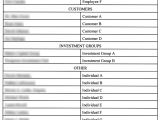The names of 25 witnesses in a federal investigation were disclosed after a worker for the US Attorney Office of Patrick Fitzgerald in Chicago attached a confidential document when sending the criminal complaint to the press.
The office wanted to announce the arrest of John Walsh and Charles Martin, principals of One World Capital Group, a foreign-exchange dealer shut down by authorities in 2007. The two men face charges for financial fraud estimated at $15 million.
Along with the 62-page long complaint, the office worker accidentally attached a one-page chart listing the real names of people that assisted with the investigation. They were identified in the complaint only as Employee A, Customer B, etc. The names belonged to six former One World employees, four customers, two investment groups, and thirteen other individuals.
Soon after realizing the mistake, Randall Samborn, spokesman for Patrick Fitzgerald's office, sent a second e-mail, asking reporters to destroy the confidential page. The urgent notification cited “Non-public information disclosing the identities of persons not named in the affidavit.”
The Commodity Futures Trading Commission has filed a lawsuit against One World Capital Group in 2007 that lead to an asset freeze, following multiple complaints from the company's customers who could no longer access their money.
Kevin Flynn, Mr. Walsh's attorney, commented that the government's new criminal complaint against his client was shocking, because he had been cooperating with the Commission's investigation, and they were close to a resolution. “I don't believe Mr. Walsh will admit guilt of any criminal conduct,” he said.
Such accidental disclosures are rather rare, but still pose significant risks, especially when criminal investigations or minors are involved. The U.S. House's Committee on the Judiciary disclosed the e-mails of 150 informants after a worker inserted them into the “To” field of a mass e-mail rather than the “Bcc.” Many of the disclosed e-mail addresses were associated with the real names of the individuals.
We also previously reported about a preparatory firm, which accidentally made confidential information about thousands of its students available on its website. The sensitive data containing real names and birthdays was unfortunately indexed by search engines, and was available through their cache even after the firm fixed the problem.

 14 DAY TRIAL //
14 DAY TRIAL // 
